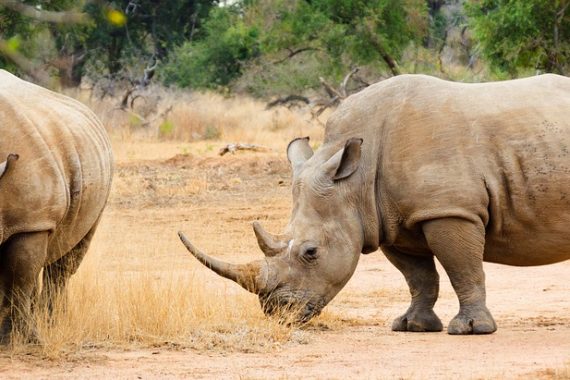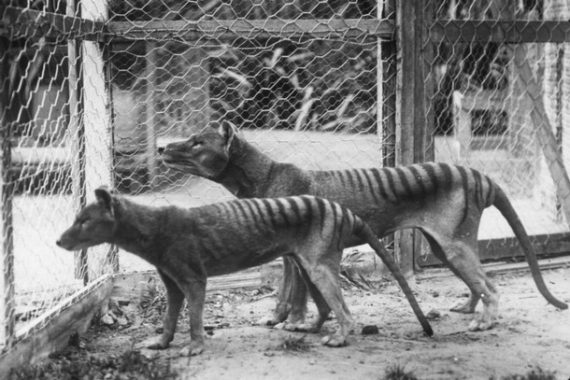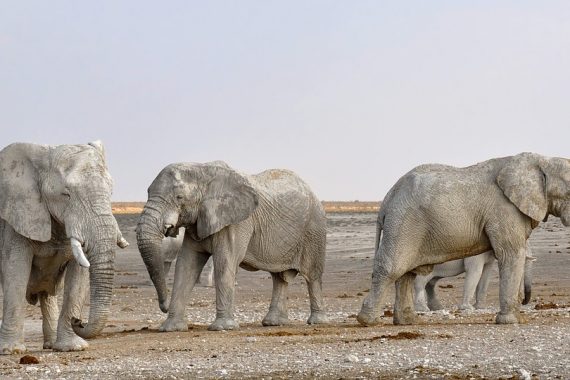Capuchin monkeys
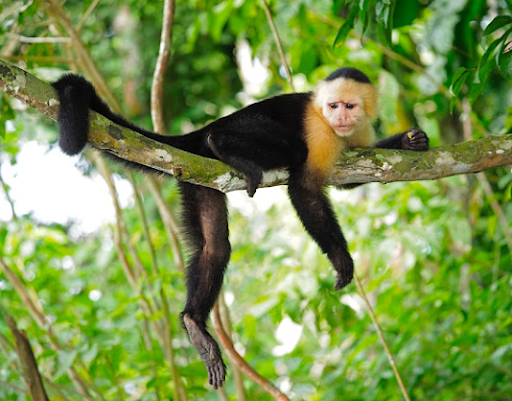
A Columbian white faced capuchin (image from www.projectnoah.org)
Cute and clever, capuchin monkeys are one of the most well-known species of primate; so well known in fact, that some of them are movie stars, starring in blockbusters like Pirates of the Caribbean, Night at the Museum and George of the Jungle. Any Friends fans will remember Ross Gellers’ mischievous capuchin Marcel and his escapades in the sitcom. But outside of Hollywood, capuchins are a diverse group of New World monkeys, called the Platyrrhini, that can be found throughout Central and South America inhabiting wet lowland forests. They are group of generally smaller, arboreal primates with 5 families, 20 genera, 156 species and 204 taxa. New world monkeys are estimated to have diverged away from the Old-World Monkeys, known as the Cattarrhini, and the great apes around 40 million years ago in the prehistoric period known as the Eocene. The ancestors of the New World monkeys reached the shores of South America on floating rafts of vegetation, likely after being swept into the ocean after a violent storm on the coast of Africa. This may sound ridiculous, but it is not the only occasion of this in evolutionary history; lemurs and tenrecs reached the shores of Madagascar in the exact same way, and even today, there are videos of vast mats of vegetation, complete with upright trees, floating down the Panama Canal. During the Eocene period, when these ancient monkeys surfed over the waves to their new home, the coasts of Africa and South America were much closer thanks to the movement of tectonic plates at that time, and so the journey would have been far more likely than it would be today. On the banks of the Río Yurúa River on the border of Peru and Brazil, scientists found a fossil site that showed the earliest evidence of the arrival of early capybaras and New World monkeys on the shores of South America.
When Portuguese explorers reached the South American continent and first spotted capuchins cavorting in the trees, with their brown head and tan faces, they were reminded of the Order of Friars Minor Capuchin, and hence they named these cute little primates Capuchin monkeys.
Although the white-headed capuchin monkey is arguably one of the most well-known species of, thanks to their Hollywood starring roles, there are 24 different species, some with several subspecies, of capuchins. Through genetic analyses, primatologists split these species into 2 genera, the robust capuchins (Sapajus), and the gracile capuchins (Cebus). These two groups are not only genetically distinct but also have some key physical differences; robust capuchins have stronger jaws for cracking nuts and have crests and beards, and gracile capuchins are longer limbed with rounder skulls. These two groups are estimated to have split apart from each other 6.2 million years ago, and it is hypothesized that the development of the mighty Amazon River was behind this division, as groups were trapped on either side of the impassable rush of water.
Not so monkey brained? The intelligence of the Capuchin monkey
Capuchin monkeys hold the lofty title of being the most intelligent New World monkey, and it is well deserved. They have the largest brain for body size of any monkey, can live up to 50 years old and have complex social groups and interactions. When the white-headed capuchin genome was sequenced, geneticists found that multiple genes encoding brain development and longevity are under extreme positive selection pressure. Comparisons of genes from capuchins in different habitats (ie: rainforests vs dry forests with seasonal droughts) found habitat specific selection of genes, such as genes for improved kidney function and altered metabolism, suggesting that capuchins have adapted successfully to different habitats, showing ecological flexibility. This intelligence and flexibility has a long history in the capuchin monkey, with evidence of tool use from 3000 years ago found at a site in Brazil, where piles of differently sized stone tools used to crack nuts were found, suggesting the monkeys trialled and tested different tools for different types of nut. This is a kind of so called ‘higher functioning’ that shows an understanding of tool use and how differently sized stones can be used.
Social intelligence is also high among capuchin monkeys, essential for living in large groups of 10 to 35 individuals with complex hierarchies defined by sex and age. These groups cover large areas and are highly territorial, marking the boundaries with urine and ferociously defending them. To keep these groups from descending into chaos, monkeys will groom each other and communicate with a complex range of vocal calls to keep in touch or warn each other that a predator is skulking around. Years of behavioural studies from Costa Rica on white faced capuchins revealed that older capuchins often invent new types of social behaviour which appear to function as tests of friendships or displays of strength against enemies. They also appear to develop games and new ways to play with infant monkeys, and although it is usually older monkeys that invent these new behaviours, juveniles have also been observed testing new behaviours to get food, like wrapping caterpillars in leaves to remove the stinging hairs, or testing out their bodies, like using twigs and vines as dental floss. There are even examples of them using basic medicine, crushing millipedes and smearing them on their backs to act as insect repellent. Capuchins have even displayed altruism, once thought to be entirely the province of humans and no other species. Capuchins are sensitive to the emotions of other monkeys, even comforting other and providing them with food in the middle of their own meal, something even chimps have never been reported to do.
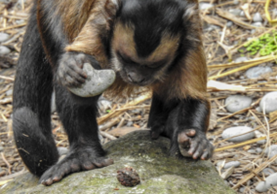
An example of a capuchin using tools to smash a nut (image from www.discovermagazine.com)
Can you imagine a capuchin businessman, perhaps running his very own banana shop? What happens if you give a monkey a dollar? Well, a famous experiment from the 2000s showed that capuchins are even capable of understanding money and how to exchange it for food items. In this experiment, 2 monkeys were placed in individual cages, with a lever in the cage. Whenever the monkey pulled the lever, the other monkey would receive food. The monkeys soon showed co-operation, with each pulling the lever in turn after each other, so they both received the same amount of food. They then introduced a small silver disk as a type of currency and taught the capuchins that they could exchange the token for food, and that different food items were worth different amounts of tokens, just like the way food is priced in the supermarket. Each monkey was given 12 tokens and allowed to trade them for different food items, like a grape or a cup of Jell-O. Over time, the researchers changed the ‘prices’ of food, for instance dropping the number of tokens needed for the more ‘expensive’ Jell-o, and the monkeys behaved the exact same way the stock markets behave stocking up on Jell-o, forgoing the grapes.
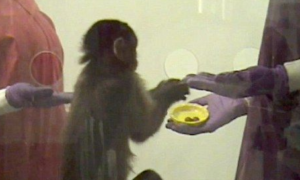
Capuchins learning to exchange money for food items with primate researchers (image from www.neatorama.com)
One marker of the highest intelligence is self-awareness, or the ability to recognise oneself, often evaluated in animals using the mirror test. This is an experimental design that involves testing the animals reaction to their reflection in a mirror; can the individual recognise their reflection as themselves and not as another animal? Famously, dolphins and elephants appear to show self awareness when they are exposed to the mirror test. When capuchins are tested, they react with behaviour that is somewhere between recognising their reflection as themselves or as another animal. To test this, behavioural scientists gave the capuchins three scenarios; seeing an unfamiliar same sex monkey, seeing a same sex monkey from their group, or a mirror. When the unfamiliar monkey was presented, the capuchins would avoid eye contact or make threatening gestures. When the familiar monkey was presented, the capuchins would show very little response. However, when they were presented with the mirror, the monkeys would make eye contact and more friendly gestures like lip smacking and swaying. These results seemed to indicate that they found the mirror a strange phenomenon but didn’t necessarily perceive it as another individual.
The organ grinder: capuchins and their relationships with humans
Often seen throughout history as the ‘organ grinder’ or ‘greyhound jockey’, capuchins have long been kept as exotic pets. The exotic pet trade is now the third largest illegal trade in the world, and carnivores and primates like the capuchin monkey are the most traded. A study from 2021 in the US found an estimated 15,000 pet primates, with marmosets, lemurs, capuchins and squirrel monkeys being the most common species for sale. The trade in countries closer to the home ranges of these primates is suspected to be even worse. Sometimes, capuchins are trained as service animals, assisting quadriplegics with tasks around the house like fetching objects, although the American Veterinary Medical Association does not recommend non-human primates as service animals anymore due to animal welfare concerns and the risk of serious injury or disease transmission to humans. As of 2010, non-human primates are no longer listed as service animals under the Americans with Disabilities Act. Life in captivity, outside of zoos with trained professionals and the correct diet, can have a massively harmful impact on capuchins physiology and behaviour. Primate biologists have studied capuchins rescued from the illegal pet trade and found significantly more abnormal behaviours in those primates that were kept alone as a single pet compared to those monkeys kept in social groups. Those capuchins that lived isolated lives foraged less frequently for food. Even after years of careful rehabilitation, these primates kept as single pets never fully recovered and still displayed the hallmarks of stress and poor social interactions for the rest of their lives. Many primates can become incredibly aggressive in captivity and suffer from constant, debilitating medical conditions. Bizarrely, despite the obvious issues with keeping primates as pets, it is still legal to sell and keep primates in many countries, including the UK and the US. A quick google search reveals how it is all too easy to buy a marmoset monkey or capuchin with a few clicks of the mouse. Even more sadly, many of these monkeys on the market are hunted from wild, ripped away from the social group and forced into tiny cages to be transported over the world to fuel the human love of a small, cute, furry mammal pet. Stick to hamsters and cats and dogs, everyone.
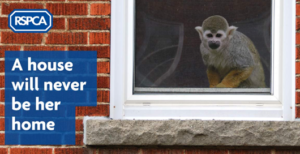
A campaign from the British animal welfare charity the RSPCA highlighting the dangers and cruelty of keeping pet primates (image from https://campaigns.rspca.org.uk/)
On top of the illegal pet trade, capuchins are often hunted for their meat, with hunting pressures in certain parts of their range reaching unsustainable levels. Luckily, capuchins have a fast reproductive rate and are fairly adaptable to changing conditions, and so the high levels of deforestation across their South American range affects them a little less than other species, but habitat fragmentation alongside the removals of juveniles for the illegal exotic trade threatens many capuchin species, with many of them classed as vulnerable and endangered by the IUCN.
Conservation Optimism
Monkeys are charismatic, much-loved species, and fortunately there are many conservation organisations dedicated to primate conservation that include capuchins and tackling the habitat loss and pet trade that threatens them.

Neotropical Primate Conservation is a registered charity dedicated to the conservation of primates and their habitats in Central and South America, founded in 2007 by a group of friends in the UK who felt a drive to conserve monkeys in the wild. Monkeys are their flagship species, but their work doesn’t just conserve them but also works to build thriving ecosystems and support the local communities that rely on the rainforest. They tackle the illegal trade on the front lines, rescuing and rehabilitating trafficked primates.
You can check out their conservation work and research at: https://neoprimate.org.

Monkey world is a primate charity and park based in Dorset, UK that rescues primates globally from terrible situations they have been smuggled into. This charity was set up in 1987 by Jim Cronin, initially to provide chimpanzees abused for entertainment on Spanish beaches a stable, caring home and to rehabilitate them from the suffering they had endured. Now they work with governments across the world to tackle the illegal trafficking of primates from their homes Africa and Asia. Although chimpanzees were the key species the park was founded on, today there are over 20 species of primates from orangutans to lemurs and slow lorises, including 60 capuchins living in 5 social groups. Most were rescued from a biomedical lab in Chile, and the rest were seized from the European pet trade. Visitors can see all of these individuals in a trip to the park, as well as supporting their vital conservation and rescue work.
Check them out at https://monkeyworld.org and if you’re in the UK or planning on visiting soon, why not take a trip to the park!
Awesome videos!
References
Alfaro, J.W.L. Silva, J.D.S.E. and Rylands, A.B. (2012) ‘How different are robust and gracile capuchin monkeys? An argument for the use of Sapajus and Cebus.’ American Journal of Primatology.
Bee, K. (2017) ‘The long term effects of social deprivation on black capped capuchins (Sapajus apella) rescued from the primate pet trade.’ The Plymouth Student Scientist.
de Waal, F.B. Dindo, M. Freeman, C.A. and Hall, M.J. (2005) ‘The monkey in the mirror: hardly a stranger.’ PNAS
https://www.rspca.org.uk/adviceandwelfare/pets/other/primates
Orkin, J.D. Montague, M.J. Tejada-Martinez, D. Manuel, M.D. del Campo, J. Hernandez, S.C. Di Fiore, A. Fontsere, C. Hodgson, J.A. Janiak, M.C. Kuderna, L.F.K. Lizano, E. Martin, M.P. Niimura, Y. Perry, G.H. Valverde, C.S. Tang, J. Warren, W.C. de Magalhães, J.P. Kawamura, S. Marqués-Bonet, T. Krawetz, R. and Melin, A.D. (2020) ‘The genomics of ecological flexibility, large brains, and long lives in capuchin monkeys revealed with fecalFACS.’ PNAS
Ottoni, E. and Izar, P. (2008) ‘Capuchin monkey tool use: overview and implications.’ Evolutionary Anthropology Issues News and Reviews.
Perelman, P. Johnson, W.E. Roos, C. Seuánez, H.N. Horvath, J.E. Moreira, M.A. Kessing, B. Pontius, J. Roelke, M. Rumpler, Y. Schneider, M.P.C. Silva, A. O’Brien, S.J. Pecon-Slattery, J. (2012) ‘A molecular phylogeny of living primates.’ PLOS Genetics.
Perry, S.E. (2011) ‘Social traditions and social learning in capuchin monkeys (Cebus).’ PNAS
Perry, S.E. Barrett, B.J. and Godoy, I. (2017) ‘Older, sociable capuchins (Cebus capucinus) invent more social behaviours, but younger monkeys innovate more in other contexts.’ PNAS
Seaboch, M.A. and Cahoon, S.N. (2021) ‘Pet primates for sale in the United States.’ PLoS ONE


